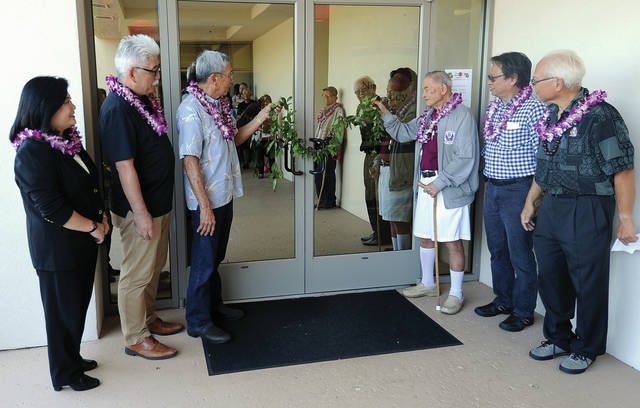Connecting past and present: Nikkei Legacy Exhibit promotes contributions of Japanese immigrants

Byrnes Yamashita explains the significance of photos displayed at the Hawaii Nikkei Legacy Exhibit Thursday at the Hawaii Community Federal Credit Union Kaloko Branch. (Laura Ruminski/West Hawaii Today)

A Japanese mask is on display at the Hawaii Nikkei Legacy Exhibit Thursday at the Hawaii Community Federal Credit Union Kaloko Branch. (Laura Ruminski/West Hawaii Today)



A Japanese sword is displayed at the Hawaii Nikkei Legacy Exhibit Thursday at the Hawaii Community Federal Credit Union Kaloko Branch. (Laura Ruminski/West Hawaii Today)

KALOKO — More than a chance to learn about the history and contributions of Japanese immigrants and their descendants, the Hawaii Nikkei Legacy Exhibit at the Hawaii Community Federal Credit Union is — for its organizers — an opportunity for people to understand what that history means for today’s world.
KALOKO — More than a chance to learn about the history and contributions of Japanese immigrants and their descendants, the Hawaii Nikkei Legacy Exhibit at the Hawaii Community Federal Credit Union is — for its organizers — an opportunity for people to understand what that history means for today’s world.
“The larger context of this exhibit is to improve relations between the people of America, specifically Hawaii, and the people of Japan,” said Byrnes K. Yamashita, exhibit co-chairman at Nisei Veterans Legacy. “We already have a strong relationship, but the idea is the more we can understand about each other, the better the relationship will be.”
The exhibit, which opened Thursday at the Hawaii Community Federal Credit Union on Olowalu Street in Kaloko, charts the contributions of Japanese immigrants and their descendants on the state’s history starting with the arrival of the Gannenmono, the first Japanese immigrants to come to Hawaii.
This year marks the 150th anniversary of their arrival in 1868 at the dawn of the Meiji Era. Of the 150 that came to Hawaii, said Yamashita, 50 returned to Japan and another third moved to the United States mainland or elsewhere by the time their contracts had ended. The last third, however, stayed in Hawaii and merged into the local population.
The exhibit’s photo panels and explanations continue through subsequent Japanese immigration to Hawaii as well as the experiences of immigrants’ children, the Nisei, in Hawaii as well as their contributions in World War II. The exhibit also highlights the post-war contributions of the Nisei, particularly in the culture and politics of Hawaii.
Following a tour with officials and special guests, Yamashita said the story of Japanese immigration to Hawaii is one that many can find relatable.
“Whether you came from China or Philippines or Korea, those early immigrants had their early experiences based in the plantations,” he said. “And somehow or another, they all went beyond that to enter the middle class and upper-middle class here in Hawaii.”
Tricia Buskirk, president and CEO of the Hawaii Community Federal Credit Union, said hosting the exhibit is something they’re proud of, given the credit union’s roots in the region.
“We really felt Kona had a very rich history with what the Japanese immigrants have accomplished — one being this company,” she said. “We went from 10 coffee farmers who are descendants of immigrants to over 40,000 members today.”
Yamashita said the exhibit is especially important for the state’s youth for whom 70-75 years ago “is almost like ancient history.”
“But the Hawaii that they live in today where they have the ability to aspire to any profession or position, that didn’t always exist prior to the war,” he said. “That’s the significance, that the freedoms that our young people have today did not come cheaply. They were paid for with blood on the battlefield and fights in the courts.”
“To me that’s the relevance to young people today — not so much the great things these men did on the battlefield, that’s hard to relate to,” he added, “but what they did after the war.”
Buskirk said she wants people to come away from the exhibit having experienced a new perspective referencing activities scheduled for Saturday that encourage children to do exactly that.
“And that’s something we think we all should do,” she added, “because we’re so diverse in Hawaii.”
Among Thursday’s guests were Lily Kahelelani Lyons and Ka‘ea Lyons, descendants of Tokujiro Sato. Sato came to Hawaii from Kyobashi, Japan, and was among the Gannenmono who arrived in Hawaii in 1868.
“Anything, really, to do with the merging of the Japanese and Hawaiian culture for us is so important, because it really is a part of who we are,” said Lily Kahelelani Lyons. “It’s created who we are, and I feel like it just honors him every time we participate or come to support or learn or do something, it really is in honor of our ancestor Tokujiro Sato.”
And the more people can get an authentic sense of the history and culture, she said, the better they can understand the world they live in today.
“I cannot imagine what it must have been like to be an immigrant and moving to another country,” she said. “But not only did they do it, but they were very successful, because look at the impression that they’ve made that’s life-long, forever.”
The exhibit, which runs through Nov. 28, is open Monday through Friday from 8 a.m. to 5 p.m. and Saturdays from 10 a.m. to 2 p.m. It will be closed for Veterans Day on Nov. 12, and Thanksgiving Day, Nov. 22.


